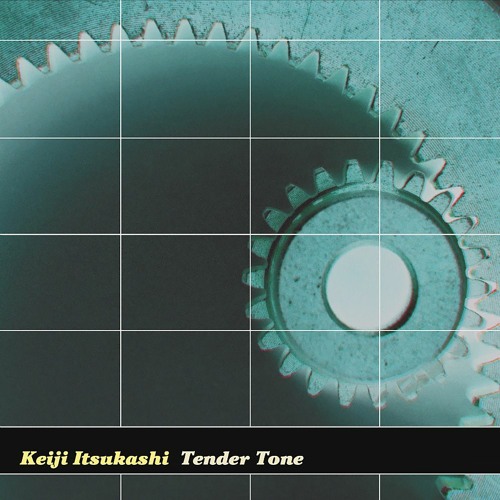No one needs a reminder of how delicate history is. But I’m reminded of it quite vividly whenever I listen to the late, great Keiji Itsukashi’s Tender Tone. Forget asking for a lossless copy. Forget finding an original CD. Forget trying to source a CD-R repress from the label that originally issued it. Just remind yourself that the only reason we’re able to hear this impressive work of Göttsching-inspired techno is because Keiji left us the ability to “Save As…”—leaving behind MP3 files on a personal website just weeks after his passing at the far-too-young age of 41, on April 24, 2010.
Born and raised in Kashihara, a suburb of Nara better known as the location of Japan’s original imperial capital, Fujiwara-kyo, Keiji found his way into music through a teenage infatuation with Japanese fusion giants Casiopea. That early love for jazz—and for artists like Pat Metheny, Chick Corea, and Kazumi Watanabe—bloomed into a search for rare groove music. With time, funk and instrumental guitar heroes like Eric Johnson and Joe Satriani carved out space in his musical world… until they didn’t.

Coming of age in the ’90s, both musically and mentally, Keiji was introduced to the world of Acid Jazz. This began a stylistic shift toward sampled grooves and programmable music. He teamed up with like-minded musicians who first traded cassettes and DATs, and in 1991 they established the Tokyo-based MYU-Recordings—a label meant to house their eclectic dance-oriented ideas under one indie banner.
Their first compilation, 1993’s Individual, captured that spirit. Distributed mainly through live performances and indie record shops, it offered a glimpse into the proto-electronica-minded minds of artists like Masaaki Yoneyama, Hidetomo Tanaka, Mitsuhiko Kondo, Water Clock, and more. In those early years, Keiji’s contributions came largely as a session guitarist and producer, lending subtle touches in unexpected places.
But a turning point came with 1995’s Translucent Sound by Ultra7. During its production, Keiji was introduced to Steve Hillage’s System 7, and the rest—as they say—was history. He was completely bowled over by Hillage’s “natural fusion of guitar and trance techno,” especially drawn to the lyrical, floating effect work. That floating quality became a hallmark of Keiji’s own exploration of progressive ideas in dance music.
As he dove deeper into that lineage, Keiji discovered the world of Krautrock, taking inspiration from Manual Göttsching, Ashra, Cluster, Harmonia, and even King Crimson—artists who could translate technical precision into emotional impressionability. That synthesis of jazz, fusion, trance, and progressive rock became his sound.

You can hear that evolution on Translucent Sound tracks like “Absolute Axis,” “SGI (Unsmooth Version),” and “Specular (ilbm-24 mix),” where Keiji pushed the limits of early ’90s consumer-level digital production and guitar effects. In a time when guitar heroes often drifted away from rhythm, Keiji’s rhythmic, exploratory guitar work felt like a new chapter in kosmische music—one rooted in feel as much as form.
It wasn’t until 1998 that Keiji released his MYU-Recordings debut, Tender Tone. Eschewing retro analog worship, Keiji instead focused on fusing the analog feel of his guitar with modern, PC-based hard disk-recorded production. According to Keiji’s notes on the album, the record opens with “Moment of Reflection,” a vocal-driven sequel to “Secret Color Map,” the song he originally wrote for MYU-REC artpop duo Water Clock. Rich harmonies and a jazz-fusion sensibility mix with a distinctive half-tone overdrive guitar sound. “Sky Blue Sky High,” originally released in 1994 on Kaleidoscope, is reimagined here with greater depth—its soaring guitar lines and techno-trance textures marking a key point in his stylistic development. The album closes with a remix of the track by Floating SYNC, lending it a more purely electronic sheen.
“Machismo” plays with a 9/8 time signature and a looping guitar motif that makes complexity feel casual. “TAW” is his minimalist homage to Göttsching, built around a hypnotic guitar figure and deep repetition. “Post Meridiem” drifts dreamily before snapping awake with one of Keiji’s favorite guitar solos—stereo-rich and subtly mindless, in the best way.
On “Brave New World,” Keiji composed an all-guitar track (save for analog drums), processed entirely in a Windows-based digital environment. “Wandering Lovers” takes an earlier instrumental and reinterprets it as a reverse cover of a vocal version by Water Clock, channeling the mellow warmth of Jeff Beck’s “Cause We’ve Ended As Lovers,” a longtime favorite of Keiji’s. “VEL.” stands out for its crisp, jazz-fusion groove with West Coast rock flavor. The short, ambient “Palmer” ends the album like a snowfall drifting into the sea—a perfect closing breath.

What’s humbling about Tender Tone is how much of it is shaped purely by Keiji’s hands. The list of gear he used on it—Fernandes and Yamaha Pacifica guitars, a 2MB Ensoniq EPS-M sampler, a Novation Bass Station, a Casio VZ-8M rack synth, Cool Edit Pro, a Zoom 8080 multi-effects unit—speaks not of abundance, but of resourcefulness. It’s low-budget gear through and through, but in Keiji’s hands, they become vessels for his compositional voice. Even as he transitioned into more club-focused productions under the name Psychedelic Lodge, you can hear a thread—a sound unmistakably his.
Unbeknownst to many, Keiji was a software engineer by trade, designing freeware tools to make computing tasks easier. That same DIY, systems-thinking approach shaped his music. With limited tools and unlimited imagination, he made something enduring. Behind all the hypnotic, floating, progressive, slightly psychedelic layers of sound was a single person—his hands on the strings, his fingers on the keys. Even at 128kbps, the magic still comes through. In the end—and in the music he left behind– that undecipherable magic is always in the hands of its creator.
FIND/DOWNLOAD

Reply